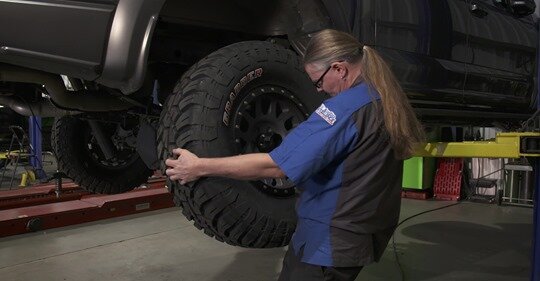HOW TIRE ROTATION CAN EXTEND THE LIFE OF YOUR TIRES
You might be asking yourself:
Why should I rotate my tires?
Should I rotate all four tires?
What pattern do I follow?
These are all great questions, and we have the answers!
Why should I rotate my tires?
Tire rotation should be part of your regular tire maintenance routine to achieve uniform wear and to maximize tread life. Rotating your tires helps equalize front-to-rear and side-to-side wear rates while enhancing wear quality and pattern noise ultimately saving you money and headaches down the road.
Should I rotate all four tires?
The tires on each wheel position accomplish different tasks and thus different wear rates and different types of tire wear will be experienced. For example, a front-wheel drive car will wear tires differently than a rear-wheel drive car. And tire wear on a performance vehicle will usually be more severe than tires on a four-door sedan.
It’s certainly an advantage when all four tires wear together as a result of regular tire maintenance and tire rotation. As wear reduces a tire’s tread depth, it allows the four tires to respond to a driver’s input more quickly. In turn, this maintains the handling of the vehicle and helps increase the cornering action of the tire. By wearing all four tires together, you can replace all four tires together allowing you to maintain the original handling balance.
It’s important to note that tire rotation cannot correct wear problems due to worn parts or incorrect tire inflation pressures.
Don’t forget the spare!
Full-size spare tires (not temporary spares), of the same size and construction as the ground contact tires, should be included in the tire rotation. And you should always check and adjust the inflation pressure of the full-size spare when incorporating it into rotation.
What pattern do I follow?
Follow the vehicle manufacturer’s recommendation for the rotation pattern and interval. Unless otherwise specified by the vehicle manufacturer, rotate your tires every 6,000 to 8,000 miles (10,000-12,000 kilometers) or sooner if uneven tread wear begins to appear. If tires start to show uneven tread wear, ask your service person to check and/or correct any vehicle wheel misalignment or other mechanical problem that may be causing the uneven wear.
Remember to adjust the tire inflation pressures according to the vehicle manufacturer’s recommendation for the new wheel position (specified front and rear position tire pressures may be different).
Please note: Do not reverse the rolling direction of directional tires.
We can help you determine the proper pattern to follow for your vehicle.
Source: General Tire





